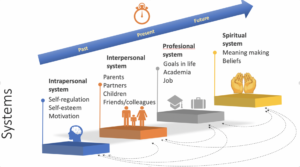Web-only Feature
Web-only Feature

Toward a New Eclectic Approach
The Internal Cohesion Psychotherapy
Have you ever felt that your clients are not benefiting from your psychotherapy approach? If not yet, then be prepared to experience the inevitable “hopelessness” one day. It seems almost impossible that your approach, solely, is going to fit all the challenges which different clients will bring in the session. However, there might be a solution!
Why Are Psychotherapists both “Rich and Poor”?
At least 500 different types of psychotherapy exist (Norcross, 2005), thus psychotherapists are “rich and poor” at the same time. Hundreds of approaches and perspectives give you the possibility to choose and adopt the one that you consider the most suitable one. However, studying each perspective may bring several dilemmas and leads you to the biggest one: “which one to choose?”. The solution to such a problem, may be an integrative approach, a more inclusive attitude toward the different psychotherapeutic models. Increasingly, many psychotherapists identify themselves with an integrative approach to psychotherapy (Boswell et al., 2010; Zarbo et al., 2015). In a large survey of over 1000 psychotherapists, only 15% indicated that they used only one theoretical orientation in their practice (Tasca et al., 2015). Practical experience and research have been the motivation to blend elements from different approaches and tailor a new model of psychotherapy, rather than following a single one.
How It Started?
Clinicians may notice that structured psychotherapies tend to help clients until a certain point, becoming stagnant. Beyond that, clients also experience challenges maintaining their improvement. This may be due to the fact that psychotherapies tend to focus on ameliorating symptoms or disorders, whereas many people seek out psychotherapy to cope more effectively with life’s challenges and have a greater sense of meaning in their lives (Cook et al., 2017). In line with these findings, recent studies have found that the ones that benefit the most when the psychotherapy process is over, are the ones who tend to have:
(1) very well-established communication or relation with their own self,
(2) a better and healthier relationship with significant figures in their lives,
(3) better academic or work performance,
(4) found a meaning of life (Uka, 2022).
A new line of evidence shows also that most patients who overcome depression or anxiety used to deal with their conflicts in the past and did better at planning their future, thus they found peace at present (Uka et al., in press).
What is Internal Cohesion Psychotherapy (ICP)?
Internal Cohesion Psychotherapy (ICP) is a new eclectic approach aiming to integrate the best practices from different perspectives yet remaining unique in conceptualizing the nature of psychopathology and its treatment. In this conceptualization, the client’s perspectives are grouped by the most important factors into categories called systems. Systems are composed of important relations that an individual has, which may directly impact psychological health and wellbeing. There are four core systems in ICP, including (1) intrapersonal, (2) interpersonal, (3) professional and (4) spiritual (Figure 1). In the ICP perspective, all the systems are strongly linked with each other, in a way that development or change in one factor influences the other ones. For example, the professional system can be influenced by the relationship that a person has with others (interpersonal system) and vice versa. Building a healthy relationship with each system in the present may not be possible without addressing conflicts from the past, or without appropriate planning for the future. As such, the element of time is crucial in this perspective.
Figure 1. Systems of Internal Cohesion Psychotherapy
“Internal cohesion”, which is the state of mind, in which clients tend to have a better relationship with all the systems and among three times is also considered. Internal cohesion is the goal of this approach and it is simply a healthier communication between the person and the four systems of human functioning. The internal cohesion is described as the condition in which (1) the person is able to communicate openly with each system and accept the past, addresses and find solutions for the open conflicts related to each system in the past, (2) establish healthy relations with each of the four systems in the present and (3) establish real and achievable expectations for the future relations with each system.
Psychopathology from the Lenses of ICP
Internal cohesion is a condition which can be disturbed on many occasions. The perspective does not focus only on one factor to identify the source of the problem the client brings into session. In this conceptualization, the problem is prone to several sources. The adverse experiences (in which we invest emotions), the maladaptive ways of thinking (focusing attention on the intensive emotional experience – projecting the most negative scenarios for the future), failure to create an objective perception, suppressed emotional contents, noncommunication of potential problems, the way how experiences and events are perceived and interpreted can influence each of the factors and systems which maintain internal cohesion. Dysfunction in one factor or system can impact other systems of functioning as well. The tendency to suppress the emotional contents of the past without processing and facing the event (experience), the denial of reality in the present and unhealthy plans for the future might be a potential source of psychological disorders in the present as well. However, when internal cohesion is established, the individual can adaptively deal with the occurring adverse experiences and events (Uka, 2022).
Goals and ICP process
The overarching objective of Internal Cohesion Psychotherapy is to help individuals reach the internal cohesion. The process involves 10 steps and each is proven to be important in reaching the overall goal (Uka, 2022).
The ICP process includes:
- Knowing – get to know clients,
- Understanding – understand the issues, problems, the challenges brought on the session,
- Evaluating – collect information and evaluate client and the difficulty/problem brought,
- Analyzing – every factor from each time will be under the therapeutic analysis,
- Accepting – accept the past as it was and accept the current reality,
- Challenging – time to challenge client’s irrational thinking, unrealistic expectations, unjustified behaviors,
- Planning – planning the actions, which reflect the balance between clients’ expectations from therapy and their potential,
- Intervening – applying different intervention techniques,
- Re-evaluating – assessing the progress in therapy,
- Releasing – the client is released when the objectives are reached and the internal cohesion is established.
ICP techniques
To build a positive and consistent relation with self and others, profession, and spiritual aspects – establishing internal cohesion – it is often necessary to apply a variety of therapeutic strategies and techniques. Around 30 techniques have shown to be effective in clinical cases, and as such, these techniques are used to achieve the overall objective in this approach. Below are shortly described four techniques:
- Moving across time. The client is asked to describe the problem from three different perspectives, answering questions such as: “How was it experienced?”, “How is it now?”, “How would you like it to be in the future?”.
- Searching for scenarios that work. This technique involves searching for scenarios that have been used in the past to deal with stressful situations and have shown to be effective. The client is encouraged to reconstruct a new scenario that has the potential to be effective in dealing with the occurring challenges.
- Often, clients attribute their feelings of ‘failure’ to the skills and abilities they lack. Through this therapeutic technique, the therapist relocates the attention of the client to the skills and abilities that would aid the client in achieving his/her objective.
- List, weigh, address. This technique requires the client to list all the challenges, difficulties, and problems, and weigh them – starting from the one which can be more easily solved to the one which is perceived as more difficult. Once the client lists and weighs the problems, the therapist requires to start addressing them ‘from the easiest to the most difficult/challenging’.
“Rational planning”, “Multiple reflections”, “The client as therapist”, “Accept and change”, “Spend and block”, “Spiritual reflections” are some of the other techniques used in this approach in order to reach the internal cohesion.
Summation
The development of modern psychotherapy speaks in favor of integrative approaches. The integration involves willingness to learn from all therapies rather than to declare exclusive loyalty to one school or model of psychotherapy (Stricker & Gold, 2011). The Internal Cohesion Psychotherapy is a tendency to bring the main lessons learned from main psychotherapy approaches. However, as any other new eclectic perspective, ICP will be prone to change and development. Future research will shape this approach and it will determine the scope of applicability and longevity.
Cite This Article
Uka, F. (2022, May). Toward a new eclectic approach :The internal cohesion psychotherapy. [Web article]. Retrieved from http://www.societyforpsychotherapy.org/toward-a-new-eclectic-approach
References
Boswell, J. F., Nelson, D. L., Nordberg, S. S., McAleavey, A. A., & Castonguay, L. G. (2010). Competency in integrative psychotherapy: Perspectives on training and supervision. Psychotherapy: Theory, Research, Practice, Training, 47(1), 3.
Cook, C. S., Schwartz, C. A., & and Kaslow, J. K. (2017). Evidence-based psychotherapy: Advantages and challenges. Neurotherapeutics, 14(3), 537–545. 10.1007/s13311-017-0549-4
Norcross, J. C. (2005). A Primer on psychotherapy integration. In J. C. Norcross & M. R. Goldfried (Eds.), Handbook of psychotherapy integration (pp. 3–23). Oxford University Press. https://doi.org/10.1093/med:psych/9780195165791.003.0001
Stricker, G., & Gold, J. (2011). Integrative approaches to psychotherapy. In S. B. Messer & A. S. Gurman (Eds.), Essential psychotherapies: Theory and practice (pp. 1–34). Guilford Press.
Tasca, G. A., Sylvestre, J., Balfour, L., Chyurlia, L., Evans, J., Fortin-Langelier, B., Francis, K., Gandhi, J., Huehn, L., Hunsley, J., Joyce, A. S., Kinley, J., Koszycki, D., Leszcz, M., Lybanon-Daigle, V., Mercer, D., Ogrodniczuk, J. S., Presniak, M., Ravitz, P., . . . Wilson, B. (2015). What clinicians want: Findings from a psychotherapy practice research network survey. Psychotherapy, 52(1), 1–11. https://doi.org/10.1037/a0038252
Uka, F. (2022). Teoria dhe psikoterapia e kohezionit të brendshëm. Dukagjini.
Uka, F., Gashi, Sh., Gashi, A., Musliu, A., Krasniqi, A., Statovci, A., Sopjani, V., . . . Wiium, N. (in press). The effectiveness of internal cohesion psychotherapy in treating young clients with depression and anxiety disorders: The role of developmental assets. Frontiers in Psychology.
Zarbo, C., Tasca, G. A., Cattafi, F., & Compare, A. (2016). Integrative psychotherapy works. Frontiers in Psychology, 6, 2021.






0 Comments